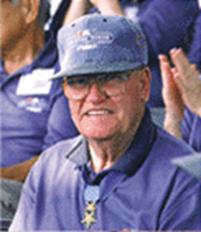|
|
Medical Readiness Is Memorial Priority
By Monte Reel, the Washington Post
May 5, 2004

More than 400 veterans from Kentucky stepped off their chartered buses and into the National World War II Memorial yesterday, but one man they had left home with wasn't among them. He died of a stroke during one of the stops along the way.
The death of 83-year-old James Henson Jr. put a face on a statistic that many of his contemporaries can recite by heart: About 1,100 World War II veterans are dying every day, according to the Department of Veterans Affairs. That number was the reason why the American Battle Monuments Commission opened the memorial to the public last week, a month before its dedication on Memorial Day weekend. It's also the reason why emergency medical arrangements have become a priority for those organizing events at the new landmark.
The memorial's drawing power among elderly Americans suggests that the medical concerns are well-founded. The National Park Service has estimated that 200,000 people a day will visit the Mall during Memorial Day weekend, for the dedication events and a four-day World War II-themed exposition being organized by the commission and the Smithsonian Institution. A large percentage will be people in their late 70s and 80s.
For the May 29 dedication ceremony alone, officials say that about 70,000 of the 117,000 people with tickets are World War II veterans or their spouses. Assuming that 35,000 are veterans, an application of the daily death rate suggests that about 10 of those with tickets will die that day.
That number is somewhat misleading; for example, it doesn't take into account that those able to attend the ceremony won't include the most frail elements of the population.
Still, organizers say they want to be on the safe side.
"Knowing [the death rate] and knowing the number of veterans expected in Washington, we always said that there's likely to be some things that happen, and we want to make sure that we're prepared for them," said Betsy Glick, a commission spokeswoman.
The commission and the Smithsonian have been holding weekly meetings for months to work out medical arrangements for the ceremony.
Nine medical tents will be erected on the Mall -- three between the Lincoln Memorial and the World War II Memorial; two between 17th Street and the Washington Monument grounds; two between 14th and Seventh streets, and two between Seventh and Third streets. Each tent will be staffed with a doctor, two nurses, a medically trained park ranger and nine emergency medical technicians, six of whom will roam through the crowds near their respective tents.
The tents also will have medical supplies, defibrillators and cots and will be outfitted with telephone lines in case cellular telephone signals and radio signals are jammed because of the size of the crowd.
In addition, nine basic life-support ambulances and four advanced life-support ambulances will be on the Mall. Nine "gators" -- vehicles similar to golf carts that can fit stretchers on them -- will circulate through the crowd. Medical volunteers will be stationed at popular bus drop-off locations, and Park Service and D.C. Fire Department EMTs will roam the area on bicycles. A medevac helicopter also will be stationed near the site, Glick said.
There will even be a geriatric dietician, who will review the menus at snack stands on the Mall to make sure they accommodate elderly eaters on restricted diets, officials said.
The cost of all those services will be paid by the commission, from private funds raised to build the memorial, Glick said.
The veterans, for the most part, are taking all of it in stride. They readily acknowledge they're getting up there in years, and they say they'll take all the help they can get. At the memorial yesterday morning, veterans Glenn E. Lewis and Noble Roberts talked about Henson's untimely death and pondered their own mortality.
"Next year, we might as well say 10 percent of these people here are going to be gone," said Lewis, 78, taking a look around at the veterans who came with him from Kentucky.
"Yep," agreed Roberts, "10 percent is probably about right."
"No doubt in my mind," said Lewis.
But it does nothing to diminish the attraction that the memorial exerts on many veterans. In fact, the years spent waiting for the memorial to open have veterans all the more eager to see it while they're able. Henson's daughter, Shirley Macklem, said that was the case with her father, who lived in Kuttawa, Ky.
"He lived in a small town, but I don't know how many people -- maybe 50 or so -- have called and said he was just like a little child looking forward to going on this trip," said Macklem, who was preparing for a memorial service for her father yesterday.
Henson slipped and fell during a stop on the bus trip, and other veterans said he joked about his clumsiness. But the driver insisted that he take Henson to a hospital, where physicians speculated that he had suffered a mini-stroke. At the hospital, Henson had a massive stroke that claimed his life.
Many of the other veterans and their wives, although saddened, said Henson's death was a little easier for them to take knowing that he died doing something that he so eagerly wanted to do. They understood his motivation for getting on a bus for a couple of days and making such a long journey because they had been driven to do the same thing.
"We took up a little collection of money on the bus to buy a wreath," said Maxine Smith, who rode with her husband of 57 years, James Smith of Paducah, Ky. "We'll give it to his family."
|
|




